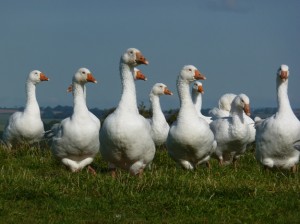
The disease occurs and is spread by domestic and wild ducks and geese (Image from www.organicgoslings.co.uk)
Poultry Diseases
Egg Drop Syndrome
Egg Drop Syndrome (EDS) causes apparently healthy birds to lay soft-shelled and shell-less eggs, frequently at times of peak production. The syndrome is caused by an adenovirus that is widely distributed in wild and domestic geese and ducks.
The egg drop syndrome 1976 (EDS 76) of domestic chickens (and occasionally Japanese quail and guinea fowl) was first recognised in 1976 and is caused by a virus of the family Adenoviridae. The EDS 76 virus circulates under conditions of natural exposure mainly in domestic ducks and geese as a latent infection but not naturally in other domestic poultry species. Free living ducks and geese of several genera and species can be also latently infected under natural conditions (Kaleta et al., 2003).
The incidence of the disease has declined as the classical form has largely been eliminated from primary breeder flocks. Organic and free-range flocks may be at a greater risk than conventional flocks, as there is likely to be more contact with wild-fowl and geese or duck carriers. EDS has been encountered in organic flocks in Denmark, and is considered a risk (Permin and Nansen, 1988). Swarbrick (1986) recorded EDS in three out of 16 free-range farms, and of these at least one was infected from wild ducks. Christensen (1994) reported high levels of antibodies to EDS 76 in a free-range flock that had contact with ducks on a farm dam and was supplied with untreated drinking water from the dam.
The first symptoms are usually weak egg shells and loss of shell pigmentation. This is followed by the production of thin, soft and shell-less eggs. Although infected birds may appear depressed for about 48 hours, there is no significant impact on their health. Although it may appear that birds have diarrhoea, this is probably the result of secretions from the oviduct.
EDS can be distinguished from Newcastle disease and Avian Influenza by the absence of illness, and from Infectious Bronchitis by the eggshell changes that occur at or just before the drop in egg production and by the absence of ridges and malformed eggs sometimes seen in infectious bronchitis (The Merck Veterinary Manual, 2006)
Spread of EDS may occur through three possible routes. Classical EDS may be introduced by means of a vaccine that has been grown in duck eggs and spread by vertical transmission via the egg. An endemic form may also spread laterally, from bird to bird, through a flock. A sporadic form can spread to chickens via direct contact with ducks, geese or infected wild birds, or indirectly through contaminated water. Antibodies against the egg-drop syndrome 1976 have been detected in wild Canada geese (Bonner et al., 2003 and Bonner et al., 2004). The virus can also be transmitted via humans, needles and egg trays.
The lateral spread of the disease can be slow. The virus has been shown to take 11 weeks to spread through a battery laying house, while affecting 4% of eggs produced (Cook and Darbyshire, 1980). Birds with antibodies slow the spread of the virus. Chicks hatched from eggs of infected hens possess maternal antibodies that confer a passive immunity to challenge for approximately the first 4 weeks of life (Darbyshire and Peters, 1980).


 American English
American English

Comments are closed.